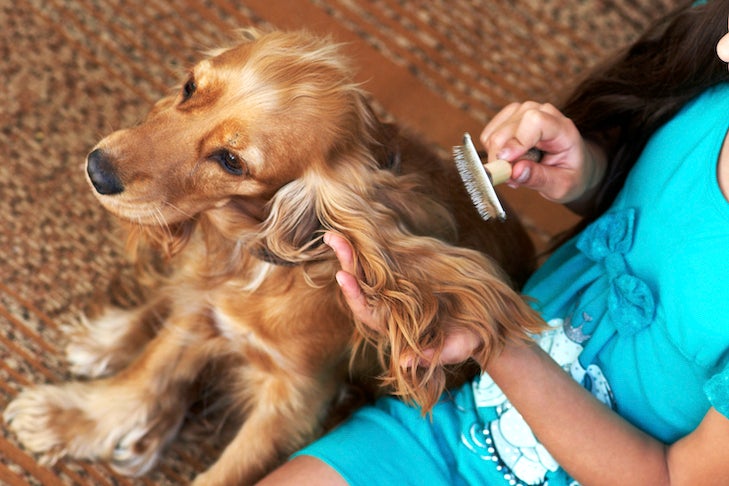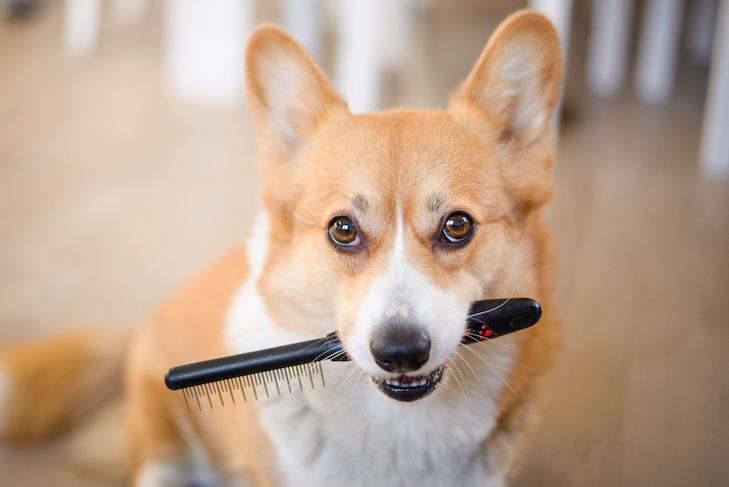AKC is a participant in affiliate advertising programs designed to provide a means for sites to earn advertising fees by advertising and linking to akc.org. If you purchase a product through this article, we may receive a portion of the sale.
Picking out the correct dog brushes to use can be confusing. The correct brush can have a big impact on the health, condition, and comfort of your dog’s skin and coat, especially if you have a long-coated or double-coated dog whose coat is prone to matting.
Whatever type of coat your dog has, brushing helps remove dirt and dead hair, serves as a time to bond with your pet, and gives you the opportunity to notice anything unusual, such as cuts or sore spots. Remember to brush the undercoat, as well as the top coat, if your dog is double-coated. If you have a puppy, start brushing right away to get them used to being handled, and use a soft brush on that fluffy puppy coat, so they’ll learn to enjoy it.

Whether you’re new to dog grooming or have simply never gotten a handle on which brushes are best to use, keep reading and we’ll teach you how to choose the right dog brush.
Types of Dog Brushes
There are many types of dog brushes on the market. We’ve listed the most common types and what they’re used for. Choose a dog brush based on the size of your dog, their breed, and their coat type.
Slicker Brushes
Slicker brushes consist of brush heads covered with short, tightly-packed wire pins angled to go through the coat and avoid the skin. Use them on medium-coated, long-coated, wire-coated, and curly-coated dogs to remove mats (and prevent mats from forming) by removing loose hair. Maintain a light touch when using slicker brushes, as pressing down hard could cause your dog discomfort.
Bristle Brushes
Bristle brushes have a large number of natural or synthetic bristles. They’re best used on short-coated dogs, including dogs with short, silky coats, to remove loose hair and dander and stimulate the skin. You can use them on double-coated breeds as a finishing brush to smooth the coat and add shine.

Pinhead Brushes
Pinhead brushes look a lot like human hairbrushes, with medium-spaced wire pins all over the brush head, often with rubber tips to prevent scratching the skin. Although commonly used, these aren’t the most versatile of brushes. They’re best used as finishing brushes for long-coated breeds to smooth the hair and remove dirt, and to work through tangles on wire-coated dogs. You can often find double-sided dog brushes that combine pinhead brushes with bristle brushes.
Undercoat Rakes
Undercoat rakes have one or two rows of metal pins designed to penetrate through to the undercoat to remove loose fur, and remove and prevent mats. You can use undercoat rakes on double-coated breeds of all fur lengths. However, you must choose the correct pin length for your dog’s coat length. Wide-toothed combs can also help remove mats and tangles.
Rubber Brushes
Rubber brushes have short, flexible rubber bristles. They’re mostly suited to use on short-coated dogs, since the bristles won’t penetrate through long or thick coats. They massage the skin and bring dirt and loose hair to the surface, where you can remove it with a bristle brush. A soft, rubber grooming mitt that fits on your hand will also remove dead hair and dirt from your dog’s coat.
Other Dog Brush Factors to Consider
Once you’ve decided which brushes you’ll need to groom your dog, there are more factors to consider:
- Brush size: You can’t expect to use the same size brush on a Chihuahua and a Saint Bernard. Choose an appropriate brush size for the size of your dog.
- Ergonomic grip: You’ll thank yourself for buying a dog brush with a comfortable, ergonomic handle after a long grooming session, especially if you have multiple dogs or long-coated dogs that take time to groom.
- Self-cleaning function: Some types of brushes, particularly slicker brushes, have a self-cleaning function. This consists of pins that retract at the press of a button, so you can easily remove hair and dirt.
- Wet/dry use: You can use most rubber brushes wet, as well as dry. They are ideal for massaging dog shampoo into pets’ coats when bathing them or brushing out dead hair and tangles from wet coats.
This article is intended solely as general guidance, and does not constitute health or other professional advice. Individual situations and applicable laws vary by jurisdiction, and you are encouraged to obtain appropriate advice from qualified professionals in the applicable jurisdictions. We make no representations or warranties concerning any course of action taken by any person following or otherwise using the information offered or provided in this article, including any such information associated with and provided in connection with third-party products, and we will not be liable for any direct, indirect, consequential, special, exemplary or other damages that may result, including but not limited to economic loss, injury, illness or death.

